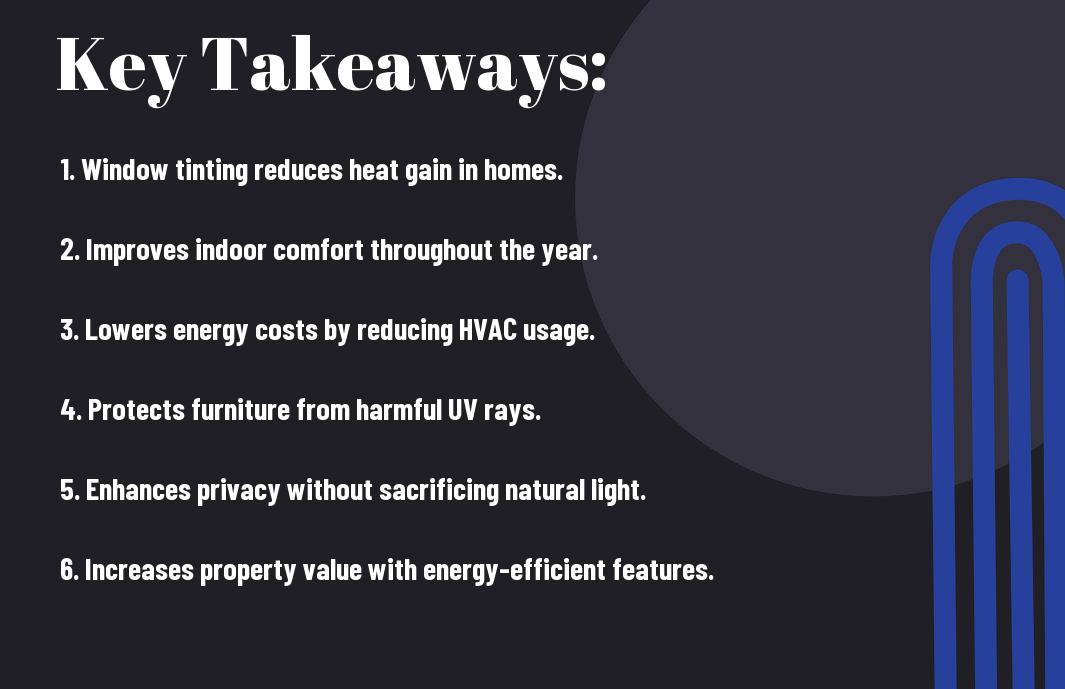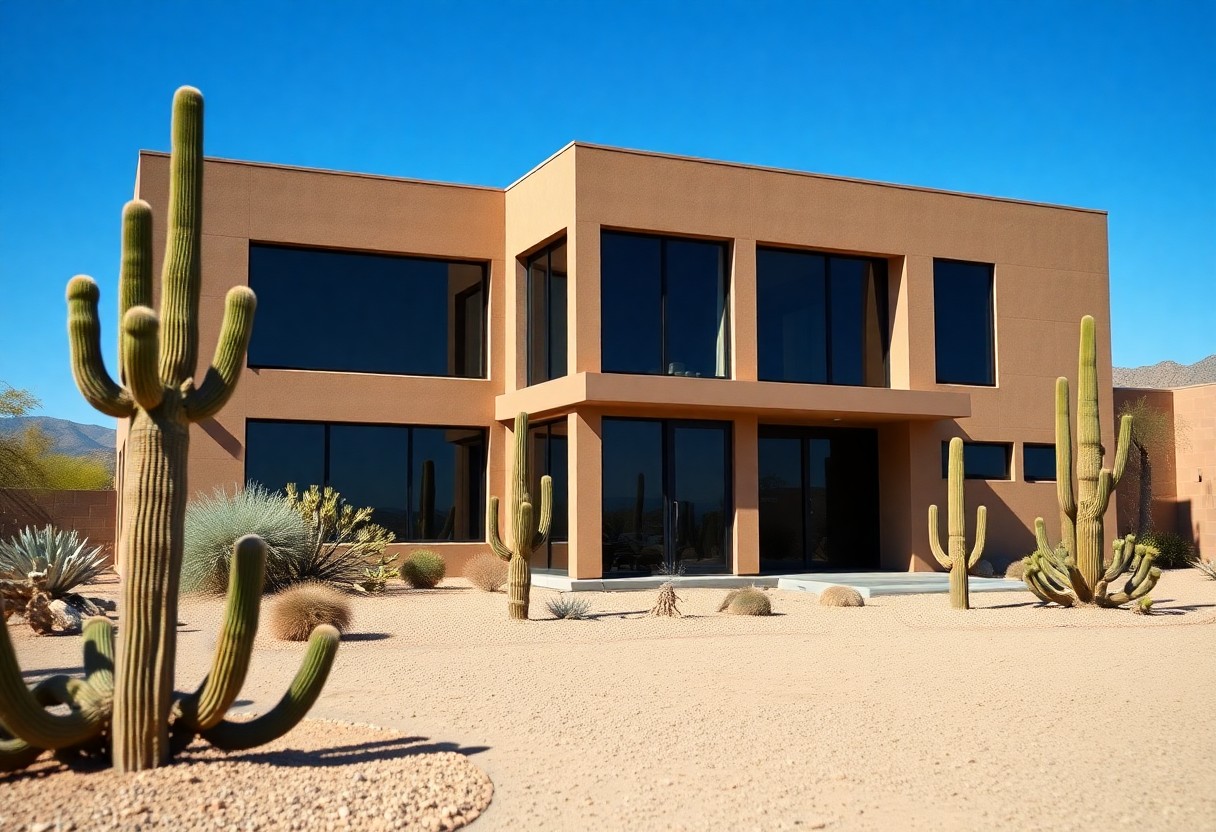It’s crucial to consider how window tinting can dramatically improve your home’s energy efficiency in Arizona’s harsh climate. By incorporating this effective solution, you can significantly reduce heat gain and glare, creating a more comfortable living environment while also lowering your energy bills. Not only does window tinting provide exceptional protection against UV rays, but it also preserves your furnishings from fading. Discover how Residential Window Tint Helps Manage Energy Efficiency and transforms your home today.
Key Takeaways:
- Energy Savings: Window tinting can significantly reduce energy costs by minimizing heat gain during hot Arizona summers.
- UV Protection: Tinted windows block up to 99% of harmful UV rays, protecting both your skin and interior furnishings from fading.
- Improved Comfort: Enhanced privacy and reduced glare improve indoor comfort, allowing for a more enjoyable living environment.
Understanding Window Tinting
The world of window tinting is filled with opportunities to improve not only the appearance of your home, but also its energy efficiency. By understanding the imperatives of window tinting, you can make informed decisions that benefit both your comfort and your wallet.
What is Window Tinting?
Beside enhancing aesthetics, window tinting involves applying a thin film on your windows to reduce sunlight penetration, thereby regulating indoor temperature. This layer works effectively to filter out harmful UV rays while maintaining your view, making your living space more enjoyable and healthier.
Moreover, window tinting can serve as a protective barrier, preventing your furnishings from fading and reducing glare from direct sunlight. This can support your HVAC systems, allowing them to function more efficiently and ultimately lowering your energy consumption.
Types of Window Films
Tinting films come in various types, each designed for specific needs and environments. Below you will find a breakdown of the most common types of window films:
| Reflective Films | These films reflect solar energy and can significantly reduce heat buildup. |
| Dyed Films | Dyed films absorb heat and UV rays, enhancing privacy without the reflective quality. |
| Metalized Films | These films have metal layers that enhance heat rejection and increase durability. |
| Ceramic Films | Non-reflective, these films provide superior heat rejection without changing the appearance of your windows. |
| Security Films | These films are designed to hold shattered glass together and enhance safety. |
- Reflective Films help with solar energy reflection.
- Dyed Films increase privacy and cut down glare.
- Metalized Films add durability and heat rejection.
- Ceramic Films excel in blocking heat without reflectivity.
- Security Films enhance safety by preventing glass shattering.
This variety ensures that you can find a solution tailored to your specific needs, providing the optimal balance between comfort and energy savings.
Benefits of Window Tinting
Tinting your windows offers numerous advantages that extend far beyond aesthetics. By applying window film, you can significantly enhance your home’s energy efficiency and comfort level. With a proper installation, you can lower energy costs by reducing the demand on your heating and cooling systems, resulting in lower monthly utility bills.
Additionally, window tinting offers benefits like improved privacy, reduced glare, and protection against UV rays that can be harmful to both your skin and your furniture. As you look to enhance your home’s functionality, consider the myriad benefits that window tinting brings.
Understanding the benefits of window tinting can help you make an informed decision about improving your home’s overall efficiency. From regulating temperature to safeguarding your belongings from UV damage, the advantages are manifold.
- Lower Energy Costs due to less reliance on cooling systems.
- Increased Privacy without blocking your view.
- UV Protection for skin and furniture.
- Reduced Glare enhancing comfort while watching TV or using devices.
- Enhanced Aesthetics giving your home a sleek appearance.
This understanding helps you make the most of window tinting as an investment into your home’s long-term efficiency and comfort.

Energy Efficiency and Its Importance
To make your home more sustainable and reduce your energy costs, understanding energy efficiency is crucial. It refers to the practice of using fewer resources to provide the same level of comfort and satisfaction within your household. By enhancing energy efficiency, you create a home environment that not only benefits your finances but also helps to protect the environment by reducing greenhouse gas emissions and energy consumption.
What is Energy Efficiency?
Above all, energy efficiency involves the adoption of technologies and practices that minimize energy waste. It can encompass various elements in your home, from appliances and lighting to insulation and windows. Homes that are energy efficient typically consume less electricity and gas, leading to reduced utility bills and a smaller carbon footprint. Implementing energy-efficient solutions can also improve the quality of life for you and your family, making your space more comfortable and enjoyable.
How Window Tinting Contributes to Energy Efficiency
Along those lines, window tinting is a powerful tool for increasing your home’s energy efficiency. By applying a specialized film to your windows, you can significantly lower heat gain from the sun during the scorching Arizona summers. This means that your air conditioning system doesn’t have to work as hard to maintain a comfortable temperature, leading to lower energy consumption and reduced utility bills.
For instance, quality window tinting can block up to 99% of harmful ultraviolet rays and up to 80% of the solar heat that penetrates your windows. This not only protects your furnishings and flooring from fading but also allows you to enjoy natural light without the discomfort of excessive heat. As a result, you can have a cooler home environment without over-relying on air conditioning, thus conserving energy.
The Role of Solar Heat Gain Coefficient (SHGC)
Behind the science of window tinting and energy efficiency lies the Solar Heat Gain Coefficient (SHGC). This measurement indicates how much solar radiation is admitted through a window, including the effects of any shading and a window’s own thermal properties. A lower SHGC rating signifies better performance in reducing heat transfer, making your home much cooler in the summer months.
This is particularly important in Arizona, where temperatures can soar during the summer. By choosing window films that offer a low SHGC, you can effectively minimize heat gain while still allowing ample natural light into your home. This not only enhances your comfort but also contributes to a more sustainable home, as reduced energy demand means a smaller environmental impact.
Window Tinting in Arizona
Unlike many other states, Arizona’s harsh desert climate presents unique challenges that can significantly affect your home’s energy efficiency. The extreme temperatures and relentless sunlight can lead to increased energy consumption as you rely on air conditioning to keep your home comfortable. By investing in window tinting, you have the opportunity to harness a range of benefits, such as reducing heat gain, lowering glare, and enhancing overall comfort in your living space. As a result, you can reduce your reliance on cooling systems and potentially see a decrease in your energy bills.
Climate Considerations
Behind Arizona’s average of over 300 sunny days per year lies a major opportunity for homeowners looking to improve energy efficiency. The intense sunlight can cause your interiors to heat up rapidly, creating an uncomfortable environment. By applying window tinting, you can effectively block a significant percentage of harmful ultraviolet (UV) rays and infrared light from entering your home, which helps to maintain a cooler interior without overworking your cooling system.
This means that you not only enjoy a more pleasant indoor environment, but you also protect your furniture, flooring, and artwork from fading due to sun exposure. Consequently, investing in window tinting serves dual purposes by enhancing comfort while preserving the aesthetic integrity of your living space.
Regulatory Environment and Tinting Laws
Climate can also shape regulations surrounding window tinting in Arizona. Various laws dictate how much light can be transmitted through tinted windows, making it crucial for you to stay informed about local ordinances to avoid unexpected penalties. Arizona law specifically outlines permissible tint levels on different windows of a vehicle, and while residential properties have a bit more flexibility, it’s important to adhere to guidelines to ensure safety and compliance.
In fact, failure to comply with these regulations can result in fines or the requirement to remove the tint, ultimately negating the benefits you initially sought. So, before you decide on tinting your windows, make sure you’re aware of the specific laws applicable to your area. A little research can save you time and trouble down the road.
Popular Tinting Options for Arizona Homes
Considerations for choosing window tinting include various films available on the market that cater to the specific needs of your home. Reflective films are a popular option, as they not only reduce heat gain but also enhance privacy by making it difficult for outsiders to see inside your home during the day. Additionally, non-reflective films can offer similar benefits without altering the façade of your home, allowing you to maintain your desired aesthetic. Each type of film has its benefits, and selecting one will depend on your personal preferences and specific requirements.
What’s more, you can choose between dyed films, metalized films, and ceramic films, each providing varying degrees of solar heat rejection, UV protection, and aesthetic appeal. This variety empowers you to customize your tinting solution that best suits your lifestyle and enhances your home’s energy efficiency.
Laws regarding window tinting can vary significantly across different regions, so it’s crucial to fall within legal parameters while making your choice. Understanding the specifications for visible light transmission, reflectivity, and other local regulations will help you select the right options that comply with the law while still achieving your desired energy efficiency goals.
Installation Process
All successful window tinting projects begin with a thorough installation process that ensures your windows are ready for tinting. This phase is important for maximizing the effectiveness of the tint and prolonging its lifespan. In Arizona, where the sun’s intensity can be damaging to both your home and your energy bills, having a properly installed window tint can make a significant difference. Knowing what to expect during the installation process will help you make informed decisions along the way.
Preparing Your Windows
To achieve the best results, you must prepare your windows properly before installation begins. Start by cleaning your windows thoroughly; any dirt, grime, or residue can prevent the tint from adhering correctly. Use a high-quality glass cleaner and a lint-free cloth to remove stains, and make sure the edges and corners are spotless, as these areas are prone to bubbling if dirt is left behind.
Next, inspect the windows for any chips or scratches. If your windows have any existing damage, it’s advisable to address these issues before proceeding with the tinting. Minor imperfections can affect the appearance and longevity of your window tint. If repairs are needed, seek professional help to ensure that the surface is smooth and ready for the application.
Professional vs. DIY Installation
Before you decide whether to hire a professional or choose a DIY approach for your window tinting, consider the complexity and skill involved in the installation. While DIY kits are available and can be tempting, the application process requires a steady hand and a keen eye for details. Improper installation can lead to issues such as bubbles, peeling, or uneven coverage, which can detract from the aesthetic and functional benefits of the tint.
Another key factor to consider is the specific regulations associated with tinting in Arizona. *Professional installers* are well-versed in these laws, ensuring that your tint complies with local guidelines, whereas a DIY attempt could inadvertently lead you to violate these important regulations.
Maintenance of Tinted Windows
For your tinted windows to remain effective and aesthetically pleasing, maintenance is important. After the installation, you should avoid cleaning the tinted windows for at least 30 days to allow the adhesive to cure properly. Once this period has passed, routine cleaning can help keep your windows looking great. Utilize a non-ammonia glass cleaner and a soft cloth to prevent scratches and damage to the tint.
Maintaining your tinted windows is not just about cleaning; it’s also important to monitor their condition regularly. Check for any signs of peeling or bubbling, as these could indicate that the tint needs to be replaced. If you notice any significant issues or if the tint has faded over time, consult with a professional for advice on the best course of action.
Preparing your windows for tinting and maintaining them afterward are both necessary steps that can significantly impact the performance and aesthetic of your investment in energy efficiency. Keeping a close watch on the condition of your tinted windows will ensure you reap the benefits of energy savings and enhanced comfort for years to come.

Cost Analysis
Not every investment in your home comes without its initial costs, and window tinting is no exception. As you consider enhancing your home’s energy efficiency, you’ll likely weigh the initial investment required for window tinting against the advantages it offers. The cost varies based on the type of film selected, the size of your windows, and the installation method. It’s important to shop around and get quotes from several professionals to ensure you receive a fair price for quality work.
Initial Investment in Window Tinting
On average, you can expect to spend anywhere from $5 to $15 per square foot for professionally installed window tinting. While this initial investment may seem daunting at first, it’s important to view it as a long-term solution that contributes to significant energy savings over time. Not only will it improve your home’s comfort, but it can also enhance the look of your property.
Long-term Savings on Energy Bills
At the end of the day, your decision to invest in window tinting is largely influenced by its long-term savings potential. By blocking out up to 99% of harmful UV rays and reducing heat gain, window tinting allows your air conditioning system to operate more efficiently. As a result, you may notice a decrease in your monthly energy bills, which can quickly offset the initial cost associated with installation.
Plus, the energy savings you’ll enjoy can be particularly beneficial during Arizona’s scorching summers when air conditioning costs can skyrocket. By cutting down on heat build-up, you can maintain a more consistent indoor climate without heavily relying on energy-guzzling cooling systems.
Return on Investment (ROI) for Homeowners
Any homeowner understands that when making upgrades, the return on investment (ROI) is a critical consideration. Fortunately, window tinting can provide a robust ROI. Not only do you save on energy bills, but the durability of window films means that many options come with warranties lasting up to 15 years or longer. This longevity makes your initial investment even more worthwhile, as you benefit over many years.
Homeowners often find that they can recoup a substantial portion of their investment in window tinting through energy savings alone. Additionally, increasing your home’s marketability and comfort can lead to increased property values. Therefore, selecting quality window tinting not only enhances your living environment but may also yield significant benefits should you decide to sell your property in the future.
Environmental Impact
After adopting window tinting in your home, you’ll find that the benefits extend beyond simply enhancing your comfort level. You are also playing a significant role in positively affecting the environment. As you make these enhancements, it’s important to recognize the ripple effect that energy-efficient practices can create, not just for your household but for the planet as a whole.
Reducing Carbon Footprint
One of the primary ways window tinting contributes to environmental sustainability is by significantly reducing your carbon footprint. By minimizing the amount of heat entering your home from the sun, tinted windows help to lower your reliance on air conditioning. This decrease in energy demand translates to less fossil fuel consumption necessary for electricity generation, leading to a decrease in greenhouse gas emissions associated with energy production.
As you embrace window tinting, you’re not merely improving your home’s energy efficiency; you’re also taking a stand against climate change. An energy-efficient home reduces the need for additional power plants, which often rely on non-renewable energy sources, further cutting down on emissions and promoting a healthier planet.
Benefits of Energy Savings for the Environment
Impact on the environment can extend far beyond your individual household. When you save energy through window tinting, you contribute to a broader movement towards sustainability. Each kilowatt-hour saved means that less energy is required from power plants, further reducing pollution and conserving natural resources. In turn, this contributes to cleaner air and water for your community and future generations.
With the practice of window tinting, you’re actively participating in energy conservation efforts that can lead to reduced strain on local ecosystems. This not only benefits your immediate surroundings but also nurtures biodiversity and wildlife habitats that can be affected by energy production and pollution.
Sustainable Home Improvement Practices
Carbon reduction isn’t just about energy-efficient windows—it’s part of a larger movement towards sustainable home improvement practices. By incorporating tinted windows into your home, you’re also setting a precedent for other eco-friendly upgrades such as energy-efficient appliances and sustainable building materials. These practices can create a holistic approach to sustainability that amplifies the benefits of window tinting.
Reducing your environmental impact through sustainable practices can take many forms, and window tinting serves as an excellent gateway to making further eco-conscious upgrades. As you explore additional changes, such as installing solar panels or using rainwater harvesting systems, your home’s overall efficiency and sustainability will continue to improve, resonating with your commitment to a better environment.
Conclusion
Presently, enhancing your home’s energy efficiency through window tinting in Arizona offers a practical solution to combat the intense heat and glare common in desert climates. By investing in high-quality window tint, you can significantly reduce solar heat gain, leading to a more comfortable living environment while lowering your energy bills. The benefits extend beyond comfort; window tinting also protects your furniture and interiors from harmful UV rays that can cause fading and deterioration over time. Implementing this upgrade is not just an investment in your home but in your overall quality of life.
As you consider options to improve your home’s energy efficiency, window tinting serves as a smart and cost-effective choice suited for the unique challenges of Arizona living. By taking this step, you position yourself to enjoy a cooler, more sustainable home. You can enhance your property’s value and contribute positively to the environment by reducing energy consumption. Make the informed choice today and elevate your home’s comfort and efficiency with window tinting.
Q: How does window tinting improve energy efficiency in my home?
A: Window tinting enhances energy efficiency by reducing the amount of heat that enters your home through the windows. The tinted film reflects solar energy, helping to maintain a comfortable indoor temperature. This means that your air conditioning system does not have to work as hard during the hot Arizona summers, resulting in lower energy bills and a more consistent climate inside your home.
Q: What types of window tinting are available for residential use in Arizona?
A: There are several types of window tinting options available for residential use in Arizona, including dyed film, metalized film, ceramic film, and low-E (low emissivity) film. Dyed film provides privacy and reduces glare while metalized film offers heat rejection and durability. Ceramic film is known for its high performance in heat and UV reduction without interfering with signals from electronic devices. Low-E films help minimize heat transfer, making them ideal for energy efficiency. Each type has its own advantages, so choosing the right one depends on your specific needs and preferences.
Q: How long does window tinting last, and is there any maintenance required?
A: Window tinting typically lasts between 10 to 20 years, depending on the quality of the film and environmental factors. Higher quality films usually come with warranties that can extend the lifespan even further. Minimal maintenance is required; simply clean the windows with a mild soap and water solution. Avoid using abrasive materials or cleaners that contain ammonia, as they can damage the tint and reduce its effectiveness. Regular care will help preserve the tint and its energy-efficient benefits for an extended period.





